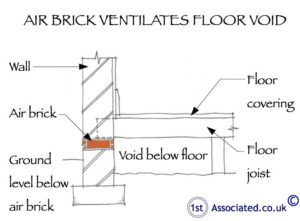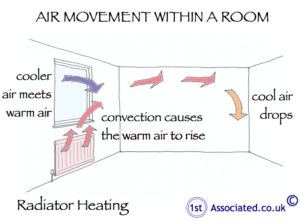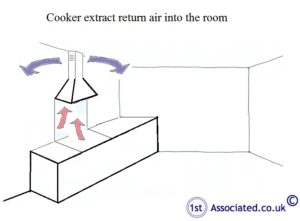Air Circulation
1stAssociated.co.uk can provide help and advice with regard to building surveys, structural surveys, independent valuations, property surveys, structural reports, engineers reports, specific defects report, home buyers report’s or any other property matters.
Please Free Phone 0800 298 5424 for a friendly chat with one of our surveyors.
The Purpose of Air Circulation
Air circulation within a building serves a number of purposes in a building primarily helping to manage humidity, and to distribute heat evenly through a room or building for the comfort of the building and its occupants. In combination with ventilation, good air circulation helps to prevent damp areas, dilute pollutants, and enhance comfort.
De-stratification
In high rooms, warehouses, church buildings and such like, air tends to stratify with temperature much higher, and relative humidity much lower at the top of a room than at ground level – which can be an issue, especially during the heating season.
With a room > 5 metres high, it is not unusual for a temperature variation exceeding 5 centigrade to build up between ceiling and floor unless the air in the space is recirculated.
For the purpose of de-stratification, efficiency is greater the larger a fan is used, and the slower it rotates. This relates to the basic mathematical relationship of E=MC2, and the consequent fact that a large slow moving fan circulates a given amount of air using a great deal less energy than a small one.
Suppose you have 2 fans:
Fan 1 – 1 metre diameter moving air at 9 m/s
Fan 2 – 3 metres diameter moving air at 1 m/s
Both fans move the same amount of air, but the large fan moves the air 9 times slower.
The energy needed by the two fans has the relationship:
9 x 9 = 81 (small fan) to 1 x 1 = 1 (big fan)
The big fan moves a given volume of air using 81 times less energy, hence selecting a large fan is hugely preferable.
In addition, the small fan will create a very noticeable “wind” in the room, the large fan very much less so.
That is why if you want to recirculate air from ceiling to floor, the bigger fan you have available, the more efficiently you can do the job.
During the heating season, de-stratification can have a major effect on the amount of heat needing to be delivered to a high building as heat which would otherwise rise to just below the ceiling is brought back down to floor level. Suppose the temperatures at the floor and ceiling are 15C and 23C respectively, use of a de-stratification fan can reduce this temperature differential substantially – possibly to 18C at ground level, and 20C at ceiling.
18C is a far more comfortable temperature to sit in than 15C, and will facilitate removal of moisture from walls so helping to dry of any damp spots such as sometimes from near floor level as a result of condensation (raising the air temperature in more humid parts of the building takes the air temperature further away from the dew point at which moisture condenses out of the air).
In summer if you want to use a fan to generate a cooling breeze, a large fan will do so more evenly than a small fan, and has far greater capacity for a given energy use. For summer cooling, it is desirable to use the fan at higher speed than for de-stratification in conjunction with opening windows.
Large slow running fans of robust design will tend to be operated way below their maximum output, making for a very long life with little wear and tear.
It is suggested to link such a fan to temperature sensors and possibly humidity sensors at floor and ceiling level to govern the operation and speed of the fan.
One supplier of large diameter fans up to 24 foot diameter for de-stratification and cooling is Big Ass Fans.
Ventilation
Air circulation as described is only part of the overall management of ventilation. There also needs to be an exchange of air between the building and outside so as to remove moisture and pollutants from a building. Opening of doors and windows, air vents and air bricks, bathroom extractor fans, cooker hoods, and mechanical heat recovery ventilation systems all play a part in the healthy ventilation of a building.
Never forget that good ventilation whilst useful in limiting damp will not fix leaks, gutter problems, and structural issues
1st Associated offers scheduled inspections to help identify issues at an early stage.
In addition to the above it is recommended to contract twice yearly gutter and downpipe clearance and inspection and visual inspection of the roof to prevent the build-up of material in the gutters and subsequent ingress of damp such as might result from blocked gutters and downpipes.
For a friendly chat with one of our Chartered Surveyors
Free Phone 0800 298 5424
Other Articles
We have written many surveying articles on this subject which may be of interest to you:
Condensation, mould and air movement in your home
We use lots of sketches in our building surveys
We use lots of sketches and photos in our reports as the feedback we have from our clients is that the sketches and photos help them understand the reports.



Independent Chartered Surveyors
If you want an independent expert opinion from a chartered building surveyor call 0800 298 5424. We carry out valuations, building surveys, structural surveys, structural reports, engineers reports, specific defects reports, home buyers reports or any other property matters.
Please contact us on Free Phone 0800 298 5424 to have a free of charge friendly chat with one of our chartered surveyors.
We feel our surveys are quite unique, as they are written to your level of knowledge. The surveys include photos and sketches and definitions. The survey will also include an action required section and an estimate of costs in the executive summary. We are more than happy to meet you at the property whilst carrying out the survey to discuss any specific issues you may have or have a general chat about what we have found at the end of the survey.

We hope you have found this article useful
We hope you found the article of use and if you have any experiences that you feel should be added to this article that would benefit others, or you feel that some of the information that we have put is wrong, then please do not hesitate to contact us (we are only human). For more information contact us on Free Phone 0800 298 5424.
The contents of the website are for general information only and is not intended to be relied upon for specific or general decisions. Appropriate independent professional advice should be paid for before making such a decision.
All rights are reserved, the contents of the website are not to be reproduced or transmitted in any form in whole or part without the express written permission of www.1stAssociated.co.uk.

